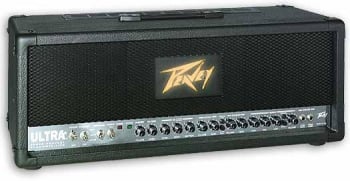Peavey Ultra Plus Review
| Line 46: | Line 46: | ||
- Footswitch: Controls channels and Reverb<br> | - Footswitch: Controls channels and Reverb<br> | ||
- And of course, the illuminated logo, more on that in just a bit<br> | - And of course, the illuminated logo, more on that in just a bit<br> | ||
| + | |||
| + | |||
| + | The active EQ differs from a passive EQ in that it cuts and boosts frequencies, where as a passive EQ cuts predetermined frequencies. One isn't necessarily better than the other, they're just different. Active EQ's do have a tendency to color the amps tone stack, so that could be desirable or not, depending on your tastes. What is does offer is an extensive frequency range, which increases tweakability. Where it really pays ff is when you're playing at low volumes, as it allows you to boost frequencies that are weak at lower volumes. This especially helpful with a tube amp, because tube amps sound really weak at low volumes. It doesn't make the tubes run hotter, so you won't have the tone you normally would at higher volumes. | ||
| + | |||
| + | |||
| + | The Ultra Plus features a preamp out, which is immensely useful as it allow you to record with a real tube preamp. You will however need a speaker emulator otherwise it will sound exceptionally buzzy. I have yet to use this feature so I can't say how well it works. | ||
| + | |||
| + | ==Channels== | ||
| + | <br> | ||
| + | |||
| + | So, now for the tones. Keep in mind tone is a highly subjective thing, and its difficult, if not impossible to be completely objective. What works for me and sounds good to me may not be the same for you. Also, the use of adjectives is highly subjective as well. For example, "boomy" to me may be "warm" to you. | ||
Revision as of 11:52, 15 November 2010
Contents |
Information
Original author: Mudbone
Weapon: Guitar amp
Make: Peavey
Model: Ultra Plus
Price: $400-600 used
Introduction
Disclaimer: This is a preliminary review, as I haven't had a chance to really crank this amp (when I say crank, I literally mean level the neighborhood ) and put it through its paces with a drummer. I've only had it a few days, so this is my initial impression.
The Peavey Ultra Plus was developed around the same time as the 5150, and is based off of the legendary Rock Master preamp. In fact, it is essentially a slight variation of the Rock Master preamp paired with a power amp. It was produced from 1995 to 2001, and was the predecessor to the Peavey Triple XXX and the 3120. Like many Peavey amps, it has been relegated to obscurity, and for many years was a cheaply traded amp on the pre-owned market. It could be found for as low as $200. However, many have recently realized that this amp can run with the big dogs, such as Mesas, Marshalls, and of course, the Ultra's sibling, the 5150.
Within the past year the price of the Ultra Plus has doubled and tripled, and now they're usually found on eBay for $400-600. However, there are a slight few who are selling the Ultra Plus that don't realize the demand for this amp has increased dramatically, so deals can still be found, albeit scarcely. This one in particular is one such deal, and it took me a long time to find it. If you want good deals on gear, you have to check the classifieds every day - trust me, you'll seriously be amazed by what you find.
Features
- 120 watts
- 4 6L6 power tubes
- 4 12AX7 preamp tubes
- Three Channels: Clean (with bright switch), Crunch and Ultra
- Master Volume
- Shared Active EQ for the Crunch and Ultra channels
- Passive EQ for the Clean channel
- Output Switch: Full or half power
- Resonance Switch: Tight, medium, or loose
- Reverb: Footswitch activated
- Low Gain and high gain inputs
- Effects loop
- Preamp out
- Footswitch: Controls channels and Reverb
- And of course, the illuminated logo, more on that in just a bit
The active EQ differs from a passive EQ in that it cuts and boosts frequencies, where as a passive EQ cuts predetermined frequencies. One isn't necessarily better than the other, they're just different. Active EQ's do have a tendency to color the amps tone stack, so that could be desirable or not, depending on your tastes. What is does offer is an extensive frequency range, which increases tweakability. Where it really pays ff is when you're playing at low volumes, as it allows you to boost frequencies that are weak at lower volumes. This especially helpful with a tube amp, because tube amps sound really weak at low volumes. It doesn't make the tubes run hotter, so you won't have the tone you normally would at higher volumes.
The Ultra Plus features a preamp out, which is immensely useful as it allow you to record with a real tube preamp. You will however need a speaker emulator otherwise it will sound exceptionally buzzy. I have yet to use this feature so I can't say how well it works.
Channels
So, now for the tones. Keep in mind tone is a highly subjective thing, and its difficult, if not impossible to be completely objective. What works for me and sounds good to me may not be the same for you. Also, the use of adjectives is highly subjective as well. For example, "boomy" to me may be "warm" to you.






